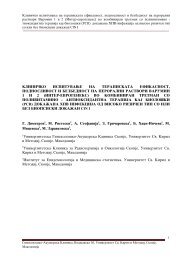klini^ko ispituvawe na terapiskata efikasnost, podnoslivost i
klini^ko ispituvawe na terapiskata efikasnost, podnoslivost i
klini^ko ispituvawe na terapiskata efikasnost, podnoslivost i
Create successful ePaper yourself
Turn your PDF publications into a flip-book with our unique Google optimized e-Paper software.
Clinical trial on terapeutic efficacy, tolerability and safety of peroral solutions Varumin 1 and 2 (Interevrogeneks)<br />
in a combined treatment with polyvitamin – antioxidative therapy in patients with biologicaly<br />
(PCR) detected HPV infection of high-risk type, with or without biopticaly verified CIN I<br />
containing Aloe should not be used by patients that suffer intesti<strong>na</strong>l obstruction or stenosis,<br />
dehydration or chronic constipation (WHO 1990), inflammatory intesti<strong>na</strong>l diseases such as<br />
appendicitis, Crohnn disease, ulcerative colitis, irritable bowel syndrome, etc. (Wichtl 1994). Aloe<br />
is not recommended for children under the age of 10. Women are not supposed to take Aloe during<br />
preg<strong>na</strong>ncy and lactation unless it is recommended and supervised by a doctor (Wichtl 1994).<br />
Patient with cramps, colic, hemorrhoids, nephritis, or any undiagnosed abdomi<strong>na</strong>l symptoms such<br />
as pain, <strong>na</strong>usea or vomiting (WHO 1999) should not intake aloe. Prolonged use of products<br />
containing Aloe can lead to hypersensitive reactions manifested in dermatitis and eczematous<br />
formations, loss of electrolytes (potassium) that may result in hyperaldosteronism, inhibition of<br />
intesti<strong>na</strong>l motility, gastrointesti<strong>na</strong>l disorders, cardiac disorders and rarely nephropathy and<br />
albuminuria and haematuria (WHO 1999, Gooding 1976).<br />
Viscum album – used raw, without previous extraction of the active substances, the whole leafs of<br />
the plant are highly toxic – 3 of the leafs are enough to induce coma.<br />
Adverse Reactions of mistletoe (Schulz V, et al. 2001, Gorter RW, et al. 1998, Foster S, et al.<br />
1999, Newall CA, et al. 1996).<br />
Common: Headache, <strong>na</strong>usea, abdomi<strong>na</strong>l discomfort, constipation, dizziness, confusion, fatigue,<br />
dry mouth, sleep disturbances, and sedation.<br />
Infrequent: Photosensitivity or photodermatitis, elevated liver function tests, acute neuropathy,<br />
increased protrombin time (PT).<br />
Case reports: Mania in 3 patients with underlying bipolar disorder. Resolved promptly in 2 patients<br />
following discontinuation while the third experienced persistent agitation for several months.<br />
Serotonin syndrome: Hypertension, diaphoresis, agitation, dizziness, and weakness with acute<br />
onset following 10 days of St. John's wort. Syndrome resolved following supportive care and<br />
discontinuation of St. John's wort.<br />
Erythroderma affecting both light-exposed and non light-exposed areas of skin. Developed 4 days<br />
after initiation of St. John's wort and resolved after 5 weeks with concomitant oral steroids.<br />
Sexual dysfunction: Decreased sexual libido that returned following discontinuation of St. John's<br />
wort.<br />
Withdrawal syndrome: Nausea, anorexia, dry retching, dizziness, dry mouth, thirst, cold chills, and<br />
extreme fatigue in patient within 24 hours of stopping treatment of St. John's wort after 32 days of<br />
treatment.<br />
Products that contain extracts or isolated components of mistletoe can cause side effects such as<br />
headache, high fever, leucocytosis, diarrhea, vomitus, orthostatic circulatory disorders, bradicardia,<br />
hyponesion, myosis, epileptic seizures and allergic reactions (German Commission E Monograph<br />
no. 228, Foster S, et al. 1999, Newall CA, et al. 1996, Schulz V, et al. 2001, Gorter RW, et al.<br />
1998, Kleijnen J, & Knipschild P. 1994, Mengs U, et al. 2002). In animal studies, some chemical<br />
components of mistletoe (tyramin and cardioactive components) stimulate the uterus (Newall<br />
1996). Due to lack of relevant data, taking into consideration the toxicity of the drug, the use of it<br />
during preg<strong>na</strong>ncy and lactation is highly restricted (Newall 1996). Products containing extracts<br />
from mistletoe are not to be used together with cardiotonic, immunosuppressive, anti-hypertensive,<br />
antidepressive and anticoagulant therapy (Hulsen 1987). The use of mistletoe is contraindicated in<br />
cases of protein hypersensitivity and chronic progressive infections such as tuberculosis (German<br />
Commission E Monograph no. 228).<br />
Propolis is considered relatively safe for use. However, some data present manifested allergic<br />
eczematous contact dermatitis in case of allergic predisposition on bee sting (Capasso 2003). There<br />
are some cases when acute oral mycosis was caused by the use of propolis - containing lozenges<br />
(Capasso 2003).<br />
Products containing extract from the root of elecampane can cause allergic reactions (Newall<br />
1986). The components of essential oil, alantolactone and isoalantolactone can lead to sensitivity<br />
University Gynecology and Obstetrics Clinic, Vodnjanska bb, University St. Cyrillus and Methodius, Skopje,<br />
Macedonia<br />
18



